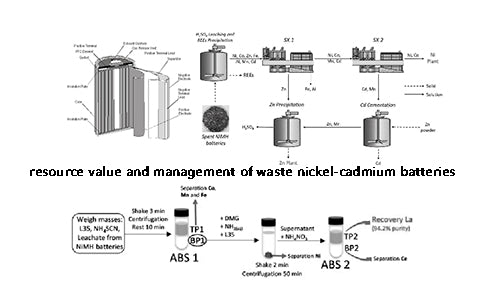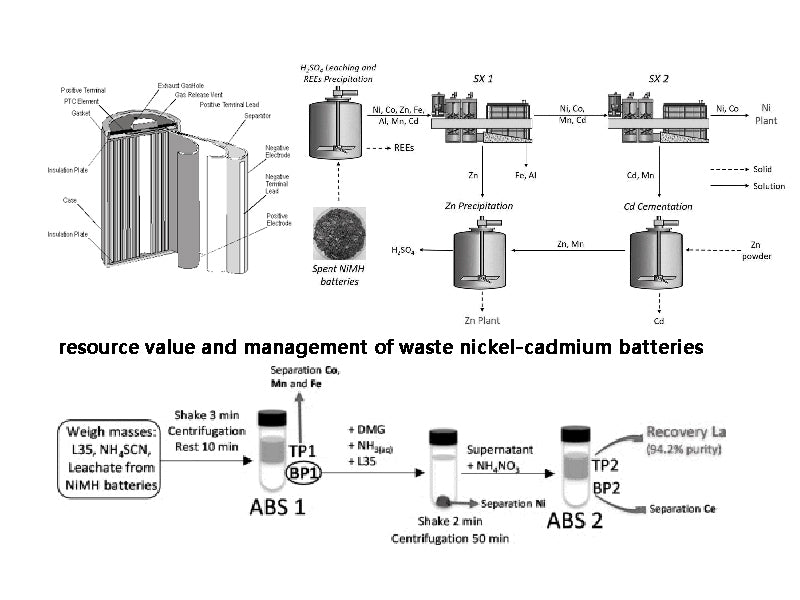
main content:
1. The resource value of waste nickel-cadmium batteries
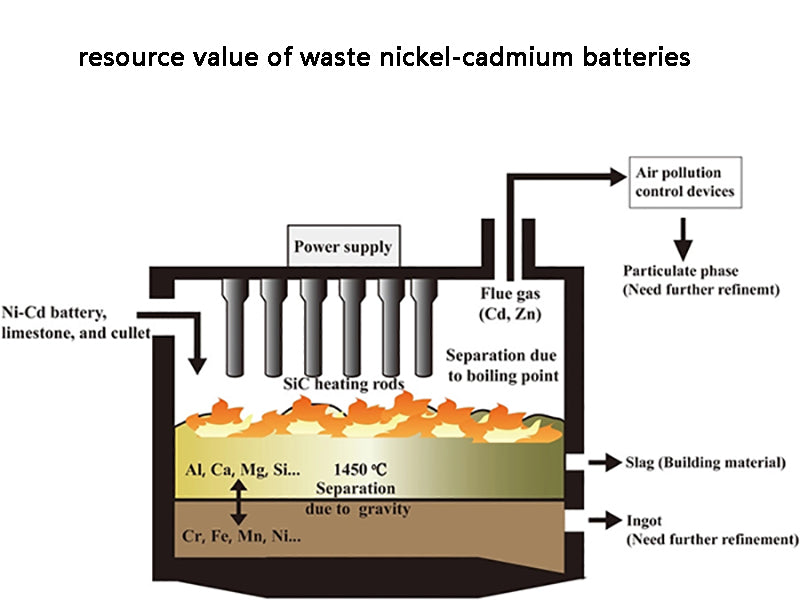
The recycling of waste nickel-cadmium batteries can make full use of resources and reduce the import of cadmium and nickel.
Cadmium is an important raw material in industrial production, and the addition of cadmium will have a significant impact on product performance. The main uses of cadmium are nickel-cadmium batteries, cadmium-containing pigments, cadmium stabilizers, cadmium coatings, cadmium alloys and cadmium compounds (such as cadmium telluride). In recent years, the main use of cadmium has shifted from traditional application fields such as pigments, stabilizers, and coatings to nickel-cadmium batteries. At present, the amount of cadmium in nickel-cadmium batteries accounts for more than 75% of the total amount of cadmium. Figure 1 shows the cadmium flow.
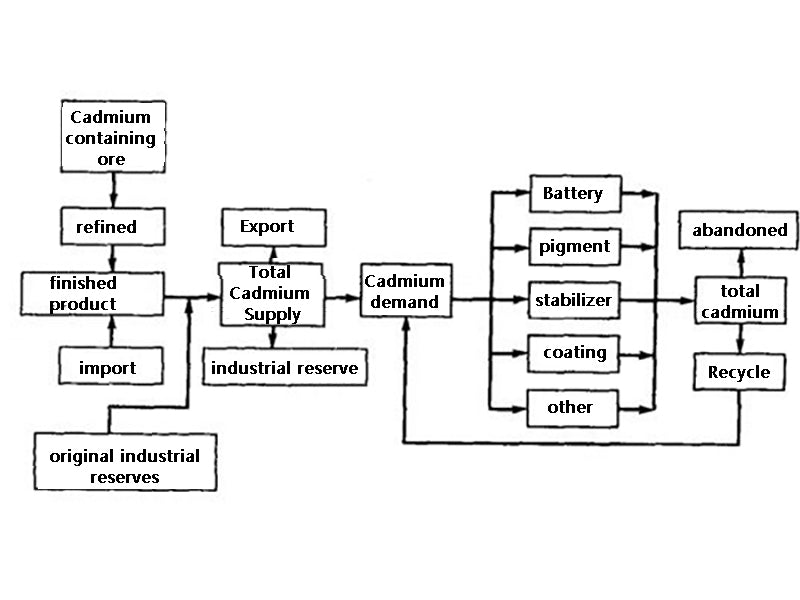
Figure 1 Cadmium material flow
As can be seen in Figure 1, the total cadmium supply mainly comes from the refining of cadmium-containing ores, imports and original industrial reserves. Among them, the use and disposal of nickel-cadmium batteries are an important part of the cadmium material flow. If the discarded nickel-cadmium batteries can be recycled and regenerated, the refining of cadmium-containing ores will be greatly reduced. Since most of the cadmium is used in the production of nickel-cadmium batteries, if cadmium can be recovered in pure metal form and used to produce new nickel-cadmium batteries, the closed-loop logistics cycle of cadmium will be the greatest protection for the environment and resources.
Cadmium is a rare metal, and the grade of its raw ore is 0.01%~0.7%. The production of 1kg of cadmium requires 10,000kg of cadmium raw ore. The cadmium content of nickel-cadmium batteries is more than 20%, and the grade is more than 200 times that of cadmium ore. Using waste nickel-cadmium batteries as raw materials to produce cadmium can reduce the consumption of raw materials, reduce energy consumption, and greatly reduce waste emissions.
The flow of nickel is basically similar to that of cadmium. The difference is that nickel cannot generally be recovered in the form of pure metal, so the recovered nickel generally cannot be used to continue the production of electrodes, but the recovered nickel can be used to produce battery casings and other nickel-containing products. The grade of nickel ore is generally less than 1%, while the nickel content of nickel-cadmium batteries is greater than 25%. It can be seen that using waste nickel-cadmium batteries as raw materials for nickel production also has great advantages.
Figure 2 is a diagram of the logistics analysis of nickel-cadmium batteries. It can be seen from Figure 2 that if the waste nickel-cadmium batteries are used as raw materials to produce new nickel-cadmium batteries, nickel ore and cadmium ore resources can be saved, and energy consumption and waste emissions in the primary nickel-cadmium metallurgical process can be reduced.

Figure 2 Ni-Cd battery logistics analysis
Carl et al. concluded through a life cycle analysis of small NiCd batteries that 65% of the energy consumption in NiCd battery production is used in battery manufacturing, and 32% is used in the production of raw materials. When using waste nickel-cadmium batteries as raw materials, the energy consumption in battery manufacturing will be reduced by 16%, and the energy consumption in raw material production will be reduced by 46% to 75%.
2. Waste nickel-cadmium battery management
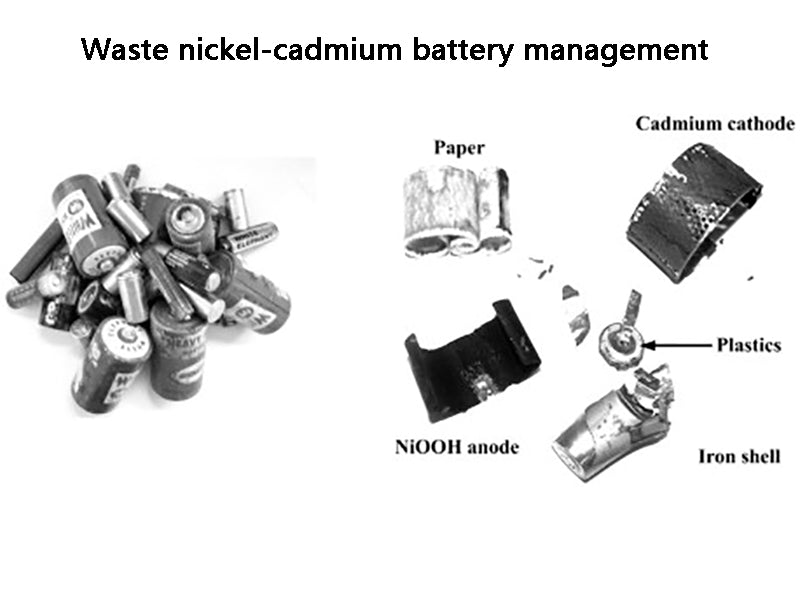
The management policies and management methods of waste nickel-cadmium batteries in various countries mainly involve the following aspects.
①The management scope is limited.
②Limited to those responsible.
③ Restrictions on usage.
④ Management restrictions on transportation, identification, collection, storage and disposal.
⑤ Some special means in the management and operation mechanism, such as the establishment of self-help organizations, the establishment of specialized agencies, etc.; the economic means that can be used in management such as taxation means, mortgage system, disposal fee management principles, etc.
1) America
For the first time in the past 10 years, the U.S. Environmental Protection Agency (EPA) has defined non-hazardous waste in small nickel-cadmium rechargeable batteries as hazardous waste. In 1995, the EPA's Waste Disposal Regulations stipulated that all waste batteries must comply with this regulation. In this regulation, the relevant responsibilities, marking, storage time, transportation, export, registration, employee training, manifest management system and other aspects are specified in detail. This regulation changes the classification of waste batteries as a common pollutant and provides for facilitating the collection and transportation of waste nickel-cadmium batteries.
In 1996, the Portable Rechargeable Battery Association (PRBA) of the United States successfully promulgated regulations related to the recycling of ordinary nickel-cadmium batteries. This regulation prohibits the addition of mercury to alkaline zinc-manganese batteries and zinc-carbon batteries, and provides detailed regulations for the labeling, transportation, collection, and storage of nickel-cadmium batteries and small lead-acid batteries. It does not specify mandatory recycling or the speed and date of completion of the program, but instead establishes a large private-sector program with specific industry sectors to increase public awareness of waste battery recycling.
As early as 1993, the US battery industry proposed a Ni-Cd battery recycling scheme. The program is called the Charge Up to Recycle program. The key part is formulated in accordance with the US EPA regulations and various other US government management plans for nickel-cadmium battery recycling and mercury-containing secondary batteries.
The Charge Up to Recycle program provides retailers, communities, commercial companies and other public organizations with different recycling programs, including the following:
①Retailer recycling program (with more than 21,000 participants);
②Community recycling program (more than 300 communities have registered);
③ Business and public institutions program (more than 1,000 companies have joined).
The U.S. secondary battery industry, under license from the Rechargeable Battery Recycling Corporation (RBPC), raises funds for recycling by stamping RBRC's Battery Recycling Seal on products. These fees are provided by secondary battery production companies and battery manufacturers powered by such batteries, while allowing their products to be stamped with the stamp. Currently, major secondary battery companies in the world have established licensing agreements with RBRC to allow products to be stamped and sold in the US market. These programs guarantee maximum recycling of small secondary batteries.
2) Japan
In 1993, the Ministry of International Trade and Industry of Japan formulated a law on the promotion of resource recycling. Nickel-cadmium batteries become the second designated management object of this law. On March 23, 1984, the Japanese Ministry of Health, Labor and Welfare issued a document, pointing out that due to strict regulations on various emission standards for municipal waste treatment plants, it is believed that household waste dry batteries can be disposed of with household waste. However, with the establishment of various spontaneous waste battery management organizations, the environmentally sound management of waste batteries has been gradually implemented. The Battery Association of Japan (BAJ) has been collecting and recycling waste nickel-cadmium batteries since 1993. Among the recycled waste nickel-cadmium batteries, the number of other types of waste batteries is gradually increasing.
Japan collects all rechargeable batteries including nickel-cadmium, lead-acid, nickel-metal hydride and lithium batteries. The completion of its collection mainly relies on the close cooperation of the corresponding industries and the support of government departments and municipal departments. The recycling of NiCd batteries collected in Japan in recent years is listed in Table 1. Its nickel-cadmium waste battery recycling and treatment plants are listed in Table 2.
Table 1 Amount of discarded Zhenpu batteries and battery waste collected in the Japanese domestic market Unit: t

Table 2 The processing capacity of the Japan Town Cadmium Waste Battery Recycling Treatment Plant

3) Europe
Most European regulations do not specify which type of battery, but apply to all batteries. Since waste batteries contain heavy metals cadmium, lead and mercury, not only separate collection but also measures to minimize and prohibit emissions must be implemented. The work of recycling waste batteries must not only involve the government, but also the industrial sector, including battery producers and sellers.
Germany is a better country for selective recycling of nickel-cadmium batteries. In the past 10 years, some companies have organized the collection of waste nickel-cadmium batteries through various channels. These waste batteries are sent to the Frankfurt area for outbound processing. Used batteries are shipped to Frankfurt in cardboard boxes. The objects collected include nickel-cadmium batteries, but in fact, more than 50% of the waste batteries collected are other types of batteries. That is to say, only 300t of the batteries collected from the 600t are nickel-cadmium batteries. Together with the collection from other sources, the total amount is about 400t per year. Compared with the German nickel-cadmium battery sales of 2000t in 1990, it can only be said that only 20% of the nickel-cadmium batteries have been collected. But at least it shows that this option for recycling is feasible.
Another way to recycle nickel-cadmium batteries is through a network of sales of battery-powered equipment. Through this route, manufacturers sell through special channels. And users, whether personal or professional, can return equipment or batteries to the manufacturer when they fail without having to go to the battery recycling department. This way the spent batteries are automatically returned to the collection point. When the waste batteries are returned to the collection point in this way, it is possible to collect them in large quantities through the equipment sales network, the after-sales service department of the battery manufacturer and the marketing department.
This method has been implemented in some countries in Europe, such as Motorola in the UK since 1993, like other companies in France, to the French company SNAM with collected waste batteries from the after-sales service network of these countries . In Germany, when consumers buy new batteries, they are asked to return their old batteries. Therefore, the industrial sector in Germany can receive 700~800t of scrap nickel-cadmium batteries every year. For scattered sellers, about 400t of scrap nickel-cadmium batteries will be received every year.


